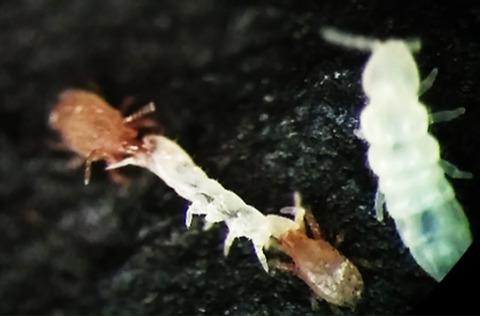当前位置:
X-MOL 学术
›
Funct. Ecol.
›
论文详情
Our official English website, www.x-mol.net, welcomes your feedback! (Note: you will need to create a separate account there.)
Water availability rather than temperature control soil fauna community structure and prey–predator interactions
Functional Ecology ( IF 5.2 ) Pub Date : 2020-12-19 , DOI: 10.1111/1365-2435.13745 Adriane Aupic‐Samain 1 , Virginie Baldy 1 , Ninon Delcourt 1 , Paul Henning Krogh 2 , Thierry Gauquelin 1 , Catherine Fernandez 1 , Mathieu Santonja 1
中文翻译:

水的可用性而不是温度控制土壤动物群落结构和猎物-捕食者的相互作用
更新日期:2020-12-19
Functional Ecology ( IF 5.2 ) Pub Date : 2020-12-19 , DOI: 10.1111/1365-2435.13745 Adriane Aupic‐Samain 1 , Virginie Baldy 1 , Ninon Delcourt 1 , Paul Henning Krogh 2 , Thierry Gauquelin 1 , Catherine Fernandez 1 , Mathieu Santonja 1
Affiliation

|
- The ongoing climate change may strongly impact soil biodiversity with cascading effects on the processes they drive. Thus, it is of prime interest to improve our knowledge about responses by soil organisms such as collembolans to expected shifts in environmental conditions by considering communities comprising both detritivores and predators.
- The aim of the present study was to evaluate how simulated climate change and predation under laboratory conditions alter a collembolan community.
- To infer the impact of climate change, we applied a decreased level of soil moisture (60% vs. 30% soil water holding capacity) and an increasing air temperature (15°C vs. 25°C) to a collembolan community constituted by four species (Folsomia candida, Protaphorura fimata, Proisotoma minuta and Mesaphorura macrochaeta) exhibiting distinct functional traits, for example, body size and furca presence, in the presence or absence of a predatory gamasid Acari Stratiolaelaps scimitus during 2 months in a microcosm experiment.
- We observed that decreasing soil moisture altered the collembolan community with species-specific responses. Interaction between soil moisture, temperature and predation indicates that low soil moisture reduced total collembolan abundance especially (a) by suppressing the positive effect of increasing temperature and (b) by increasing the predatory control on collembolan abundance.
- These results highlight that soil moisture is the major driver of Collembola community and by consequence, a shift in climatic parameters with the ongoing climate change should strongly modify the Collembola community structure and the predator–prey interaction. Our findings are highly important since a strengthening of predation impact on Collembola prey could have major consequences on the whole soil food web being able to lead to a slowdown of key ecosystem processes they drive (e.g. litter decomposition and nutrient recycling). Finally, our study promotes the need to study more complex systems considering distinct soil-dwelling species, their functional traits and their trophic interactions to better predict the ecosystem responses to the ongoing climate change.
中文翻译:

水的可用性而不是温度控制土壤动物群落结构和猎物-捕食者的相互作用
- 持续的气候变化可能会严重影响土壤生物多样性,并对它们驱动的过程产生连锁效应。因此,通过考虑由食腐动物和捕食者组成的群落,提高我们对土壤生物(如跳虫)对环境条件预期变化的反应的认识是最重要的。
- 本研究的目的是评估实验室条件下模拟的气候变化和捕食如何改变跳虫群落。
- 为了推断气候变化的影响,我们对一个由四个跳虫组成的跳虫群落应用了降低的土壤水分水平(60% 与 30% 的土壤持水能力)和升高的气温(15°C 与 25°C)。物种(Folsomia candida,Protaphorura fimata,Proisotoma minuta和Mesaphorura macrochaeta)表现出不同的功能特征,例如,体型和furca存在,在2个月的微观实验中,在掠食性gamasid Acari Stratiolalaps scimitus存在或不存在的情况下。
- 我们观察到土壤湿度的降低改变了弹跳虫群落的物种特异性反应。土壤水分、温度和捕食之间的相互作用表明,低土壤水分降低了弹跳虫的总丰度,特别是(a)通过抑制温度升高的积极影响和(b)通过增加对弹跳虫丰度的捕食控制。
- 这些结果强调土壤水分是弹尾虫群落的主要驱动力,因此,随着持续气候变化的气候参数变化应该会强烈改变弹尾虫群落结构和捕食者-猎物相互作用。我们的发现非常重要,因为加强对跳虫猎物的捕食影响可能对整个土壤食物网产生重大影响,从而导致它们驱动的关键生态系统过程(例如凋落物分解和养分循环)放缓。最后,我们的研究促进了研究更复杂系统的需要,考虑到不同的土壤栖息物种、它们的功能特征和它们的营养相互作用,以更好地预测生态系统对正在进行的气候变化的反应。


























 京公网安备 11010802027423号
京公网安备 11010802027423号